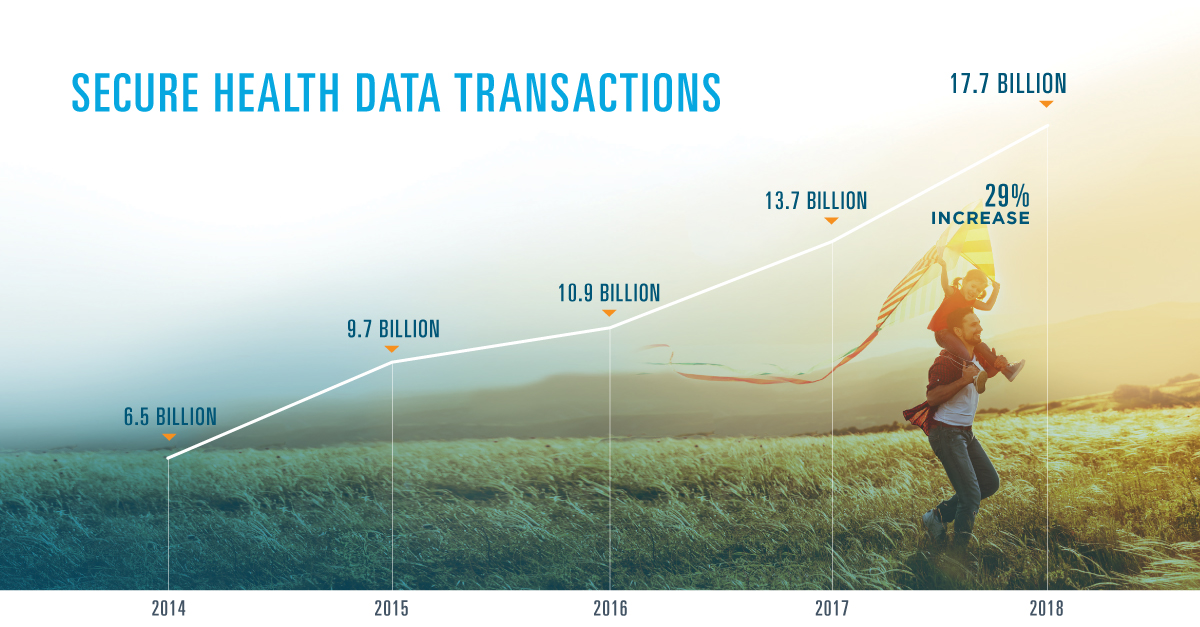New Report Shows that Significant Expansion Across the Surescripts Network Alliance®, Rapid Provider Adoption of New Technologies and Continued Innovation are Benefiting Patients and Providers
ARLINGTON, Va. – April 23, 2019 – Interoperability is occurring at scale and driving measurable improvements in healthcare quality and cost for patients and providers, according to Surescripts 2018 National Progress Report. The nationwide health information network processed 17.7 billion secure health data transactions last year—a 29% increase over 2017—among 1.61 million healthcare professionals. Surescripts also added 8 million unique patients to its master patient index, which now includes 258 million patients, or nearly 80% of the total U.S. population and 93% of all insured patients.
“This rapid growth was driven by continued expansion of the Surescripts Network Alliance®, rapid adoption of new technologies and the introduction of new innovations in the market,” explained Tom Skelton, Chief Executive Officer of Surescripts. “Together, we’re transforming interactions between patients and the people who care for them by improving prescription price transparency, enabling clinical information exchange, combating the opioid epidemic and improving prescription accuracy.”

Clinical Interoperability Delivered at Scale
Last year, the number of clinicians using Record Locator & Exchange to access patient records from anywhere in the country more than doubled to 106,000. They used the technology to access 108 million links to clinical document sources—a 586% increase over 2017—and to exchange 99 million care location summaries among 4,680 active healthcare organizations nationwide.
Record Locator & Exchange, which leverages the Carequality Interoperability Framework, was used by clinicians in new scenarios across a variety of care settings. In a series of interviews, users shared how this technology impacted patient care. For example, a triaging emergency room physician learned of a patient’s serious cardiovascular disease and ordered an immediate transfer to the university hospital for aggressive treatment. In another case, a transplant coordination team reviewed health records for a new patient with lupus, learned of a previous blood clot diagnosis and added blood-thinning medications to her treatment plan as a result.
Increasing Use of Technology is Combating the Opioid Epidemic
As nationwide opioid prescribing rates declined in 2018, the use of Electronic Prescribing for Controlled Substances (EPCS) increased by nearly half. The use of patient medication history data increased 21% as Surescripts expanded the reach of its Medication History service to include 90% of U.S. patients.
Both tools play a critical role in combating the opioid epidemic by helping healthcare providers ensure the safe and secure prescribing of controlled substances, and giving them a more complete and accurate picture of their patients’ medications.
A nearly 90% increase in e-prescriptions for buprenorphine indicated that more clinicians used e-prescribing to help treat opioid dependence and misuse. The proliferation of state legislation mandating e-prescribing for opioids, controlled substances or all prescriptions contributed to the increase in prescriber enablement, with eight more states passing mandates in 2018.
Price Transparency and Prior Authorization Tools Are Saving Time and Money
Driven by a 1,338% increase in provider adoption, in 2018, Surescripts processed 40.5 million real-time benefit checks at the point of care. Real-Time Prescription Benefit shows prescribers patient-specific, formulary-based out-of-pocket cost information for their chosen drug and their patient’s chosen pharmacy—as well as up to five therapeutic alternatives in real time within the electronic health record (EHR) workflow.
With this tool, prescribers can help patients get more affordable prescriptions faster and with less hassle. In 2018, prescribers used Real-Time Prescription Benefit to save their patients an average of $105 per prescription for antidepressants, and $88 per prescription for blood glucose-lowering medication (excluding insulin).
Provider adoption of electronic prior authorization also surged 128% with data supplied directly from pharmacy benefit managers and health plans covering 89% of U.S. patients. And as of 2018, 80% of U.S. prescribers were using EHRs contracted to implement the solution—a 58% increase over 2017.
Enhancing Patient Safety and Care Quality with Better Data
In 2018, Surescripts improved the accuracy of e-prescription transactions by 14%—representing a 64% improvement since 2016—by improving physician and pharmacy directory alignment, driving broader adoption of appropriate transactions and other factors. As a result, physicians and pharmacists spent less time exchanging phone calls and faxes to clarify prescriber intent. To honor the industry’s progress in improving prescription accuracy, Surescripts recognized five EHR vendors with the 2018 Surescripts White Coat Award™.
Download the Surescripts National Progress Report. Visit surescripts.com to learn more about solutions that enhance e-prescribing and inform care decisions. And explore Intelligence in Action to see Surescripts’ work to advance healthcare.


 Dean Riggott Photography
Surescripts
Dean Riggott Photography
Surescripts
